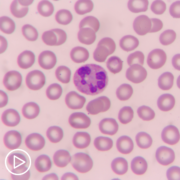Myeloproliferative Neoplasms Archives
Myeloproliferative neoplasms (MPNs) are a closely related group of progressive blood cancers in which the bone marrow typically overproduces one of the mature blood elements. Other shared features include tendencies toward blood clotting/bleeding, organ enlargement, bone marrow scarring (fibrosis) and a possibility of transformation.
More resources for Myeloproliferative Neoplasms from Patient Empowerment Network.
What Is the Role of AI in Telemedicine for MPNs?
What Is the Role of Artificial Intelligence (AI) in Telemedicine for MPNs? from Patient Empowerment Network on Vimeo.
How does artificial intelligence (AI) fit into the myeloproliferative neoplasm (MPN) care toolbox? Dr. Kristen Pettit from Rogel Cancer Center explains the current role of AI, her hopes for the future of MPN care, and what she considers the ideal model for MPN care.
See More From the MPN TelemEDucation Resource Center
Related Resources:

|

|

|
Transcript:
Dr. Kristen Pettit:
I think the role of artificial intelligence and telemedicine in MPN fields is going to be evolving over the next few years. I think one thing that will be very interesting that I’m very interested in seeing is whether we’re able to incorporate things like data from wearable devices, for example, like your Apple Watch or those sorts of devices directly into your healthcare to be able to monitor you on a more continuous basis and virtually, I think more things of that nature will be coming over the next couple of years.
I think that incorporating telemedicine into MPN monitoring is a relatively safe thing to do for most patients, very rarely things will come up in an in-person visit that might not have been reported or caught on a telemedicine visit, for example, slight changes in spleen size that we may be able to feel in the office that might not be symptomatic to the patient at home or might not be noticed at home could happen. Other things like weight loss that a person might not necessarily have noticed at home, but that we would hopefully pick up on it.
An office visit might be another thing to think about, but both of these situations, I think are relatively uncommon, I think the most important thing is for a patient and their family members to know their body, know their symptoms, keep an eye out for any changes, while they’re at home, and as long as that’s being done, really, I think telemedicine is relatively safe to incorporate in MPN care. Ideally, I think that would be done sort of intermittently or alternating between virtual visits and in-person visits with an individual patient.
How Does Artificial Intelligence (AI) Improve MPN Patient Care?
How Does Artificial Intelligence (AI) Improve MPN Patient Care? from Patient Empowerment Network on Vimeo.
Myeloproliferative neoplasm (MPN) patients can benefit from increased use of artificial intelligence (AI) in their care. Watch to learn about patient care improvements from AI, what it means for MPN patients, and potential future developments in AI.
See More From the MPN TelemEDucation Resource Center
Related Resources:

|

|

|
Transcript:
The use of artificial intelligence (AI) in telemedicine is ever expanding. In telemedicine visits, AI can provide translations for non-native English speakers, more efficient analysis of imaging and other tests, use algorithms to better predict staffing levels for improved patient care, and much more.
The increased use of artificial intelligence translates to improved care for MPN patients. Patient health can be monitored more frequently, more time can be spent with each patient, and tests can be evaluated more accurately through analysis by both providers and AI. These benefits will result in monitoring of treatment and symptoms more often for optimal patient care.
As artificial intelligence continues to evolve, patients are apt to see even more treatment advancements and personalized care. Quality of life should improve as MPN specialists can spend more time learning about the latest MPN treatment advancements and to focus more on patient health outcomes.
Please remember to ask your healthcare team what may be right for you.
New Developments in MPN Care
New Developments in MPN Care from Patient Empowerment Network on Vimeo.
Does myeloproliferative neoplasm (MPN) care have new developments? Dr. Kristen Pettit from Rogel Cancer Center shares MPN research updates she hopes to hear about at ASCO 2022.
See More From the MPN TelemEDucation Resource Center
Related Resources:

|

|
Transcript:
Dr. Kristen Pettit:
Yeah, so the ASCO 2022 meeting will certainly be exciting for MPNs, I’m expecting the abstracts haven’t been selected yet as of the time we’re discussing this, so I’m not sure exactly what’s going to be discussed. But what I’m hoping to hear more about is the investigational JAK inhibitor momelotonib for patients with myelofibrosis, specifically those with anemia, I’m hoping to see more results about that.
I’m hoping to hear more about the up-front combination studies that are ongoing in myelofibrosis, so JAK inhibitors plus novel agents compared to JAK inhibitors alone as the first treatment option for patients with myelofibrosis. I’m hoping we get some interim results or updated results from some of those ongoing studies, and I’m hoping to hear more about some of the later line treatment options for patients with myelofibrosis as well.
There are a lot of exciting things going on out there, and we’ve gotten a couple of great updates over the last year, for example, at the ASH meeting in December, and I think we’ll get some more exciting updates at ASCO in May and June.
Are Mobile-Optimized Tools Impacting MPN Care?
Are Mobile-Optimized Tools Impacting MPN Care? from Patient Empowerment Network on Vimeo.
How is myeloproliferative neoplasm (MPN) impacted by mobile-optimized tools? Dr. Kristen Pettit from Rogel Cancer Center shares digital education resources and patient education websites to aid in MPN patient support and education.
See More From the MPN TelemEDucation Resource Center
Related Resources:

|

|

|
Transcript:
Dr. Kristen Pettit:
There are a wealth of resources online in the MPN world, there are a number of different digital education resources that have expanded even with COVID, a lot of patient education materials that are out there on various different websites, from the Patient Empowerment Network to the MPN Research Foundation and MPN Advocacy & Education International.
There are also symptom trackers that can be very helpful to where you can enter your individual symptoms as often as you want to and get a more objective number to follow how you’re feeling over time and see how things may be progressing over time.
Why Is Specialized Care Important for MPN Patients?
Why Is Specialized Care Important for MPN Patients? from Patient Empowerment Network on Vimeo.
Specialized myeloproliferative neoplasm (MPN) care is an option for many patients. Dr. Kristen Pettit from Rogel Cancer Center explains various ways that specialized MPN care can benefit patients and MPN conditions that specialists are commonly trained in.
See More From the MPN TelemEDucation Resource Center
Related Resources:

|

|

|
Transcript:
Dr. Kristen Pettit:
I do think it’s important for patients to have an MPN specialist in their corner when they’re living with an MPN, that things are moving very quickly in the MPN fields in all areas, from diagnosis to risk stratification, to treatment and management over time, as well as monitoring.
So I think having someone who focuses specifically and only on MPN to is up-to-date on the most recent literature and the most recent advances, I think is an important thing, even if that’s somebody that you only maybe see either in person or virtually once a year, once every other year, or just have available if anything changes in your disease course.
So most MPNs specialists are certified in both hematology and oncology, but most focus on really all of the MPNs, these are relatively rare conditions, so most MPNs specialists will focus on ET, PV, myelofibrosis, other rare MPNs such as chronic neutrophilic leukemia, and sometimes some of the other myeloid malignancies such as myelodysplastic syndrome, for example, but your MPN doctor most likely focuses on all of those different disorders and would be able to manage your care if heaven forbid, things progress down the road from one of those MPNs to another.
Should MPN Patients and Their Families Continue Telemedicine?
Should MPN Patients and Their Families Continue Telemedicine? from Patient Empowerment Network on Vimeo.
Can myeloproliferative neoplasm (MPN) patients still get value from telemedicine? Dr. Kristen Pettit from Rogel Cancer Center explains some of the pros and cons of telemedicine visits and ways to optimize MPN patient care.
See More From the MPN TelemEDucation Resource Center
Related Resources:

|

|

|
Transcript:
Dr. Kristen Pettit:
I think telemedicine has been one of the few good things to come out of the COVID era. There are pros and cons, certainly, some pros are that patients can have increased access to their physicians and their medical teams, particularly the MPN specialty centers that might not be right in their backyard. It’s great, it’s a great way to be able to stay in touch with an MPN specialist.
The less travel, less waiting in a waiting room. Those are all great things, the cons, the downsides to keep in mind are that virtually we can’t feel for spleens, so it’s difficult to tell if the spleen is starting to get enlarged. There can also be some logistical challenges getting blood counts drawn and interpreted before a telehealth visit. But with those minor challenges, I think telemedicine is here to stay, and I think it’s an important part of the care for patients with MPNs.
Remote monitoring is very important for patients with MPNs, really the most important thing, in my opinion, for patients with MPNs being monitored over time is for them to keep an eye on their symptoms over time, watching for any changes in their bodies that they may feel as far as their spleens feeling more enlarged or feeling more full, or losing weight unexpectedly, feeling more fatigued, any of their MPN symptoms getting worse. All of those are easy to monitor at home, virtually, and to report back to your physician over telehealth or at routine visits.
What Is Chronic Neutrophilic Leukemia?
What Is Chronic Neutrophilic Leukemia? from Patient Empowerment Network on Vimeo.
Chronic neutrophilic leukemia (CNL) is a rare form of myeloproliferative neoplasm (MPN). Dr. Kristen Pettit from Rogel Cancer Center explains mutations involved in CNL and common CNL symptoms.
See More From the MPN TelemEDucation Resource Center
Related Resources:

|

|

|
Transcript:
Dr. Kristen Pettit:
Chronic neutrophilic leukemia or CNL is a pretty rare myeloproliferative neoplasm. So when we think of MPNs, we more commonly think of ET, PV, or myelofibrosis but there are a couple of other rare subsets and CNL is one of those. CNL is often driven by slightly different mutations as opposed to PV, ET, or myelofibrosis. One common genetic mutation to see in CNL is involving a gene called CSF-3R.
The actual symptoms of CNL are often similar to what’s in seen in other MPNs. We often see constitutional symptoms like fatigue, fevers, chills, night sweats, those sorts of things. We often see splenomegaly as well, the blood count profile looks a little different in CNL, what we typically see is relatively high white blood cell counts made up mainly of mature neutrophils in that white blood cell differential.
The treatments of CNL are somewhat similar to other MPNs, but maybe a little bit different depending on the specific genetic mutation that’s identified for the individual patient.
Notable New MPN Treatments
Notable New MPN Treatments from Patient Empowerment Network on Vimeo.
What’s the latest in myeloproliferative neoplasm (MPN) treatments? Dr. Kristen Pettit from Rogel Cancer Center gives updates about treatment developments for myelofibrosis, polycythemia vera (PV), and essential thrombocythemia (ET) care including JAK inhibitors, BCL-2 inhibitors, BCL-XL inhibitors, BET inhibitors, and others.
See More From the MPN TelemEDucation Resource Center
Related Resources:

|

|

|
Transcript:
Dr. Kristen Pettit:
There are so many new treatments in MPNs that I’m excited about, so one that is investigational that has been moving through the pipeline is momelotonib, which is a newer JAK inhibitor for patients with myelofibrosis. The mechanism of action is slightly different than the other JAK inhibitors, ruxolitinib (Jakafi), baricitinib (Olumiant), and pacritinib that’s improved as well.
The hope with momelotonib is that it will do some of the good things that the other JAK inhibitors do reduce symptoms and reduce spleen size, but also potentially improve anemia for patients who struggle with anemia, which is such a high proportion of our patients with myelofibrosis. I think that’s one exciting thing, another exciting avenue are new potential up-front treatment strategies that are being studied, so there are a number of different clinical trials going on right now, testing the strategy of either standard ruxolitinib or Jakafi by itself compared head-to-head versus a combination of Jakafi plus another medication.
Those other medications that are being tested in trials include the BET inhibitor called parsaclisib, also BCL-2, BCL-XL inhibitor called navitoclax, and a Pi3 Kinase inhibitor called parsaclisib. These upfront head-to-head treatment strategies are going to be very important to keep an eye out for over the next couple of years. The hope is that these combination strategies could deepen responses and potentially prolong responses when a new drug is combined with the JAK inhibitor as the first treatment option for patients with myelofibrosis. In the later line setting, one thing that’s exciting is Imetelstat, which is a telomerase inhibitor.
This is the first study in my myelofibrosis that is trying to specifically prove whether or not it is linked in survival for patients with myelofibrosis. So, I think that’s very exciting and something to keep an eye out for.
In polycythemia vera, one newer treatment option that’s getting a lot of excitement is the Hepcidin mimetic called rusfertide, this medication will hopefully harness the body’s iron metabolism pathway and act as sort of a chemical phlebotomy as opposed to an actual therapeutic phlebotomy in order to control the hemoglobin and hematocrit for patients with PV as well as improve symptoms.
In ET the newer agents that are being investigated include the BET inhibitor parsaclisib, is also being studied for myelofibrosis as well as an LSD-1 inhibitor called bomedemstat. Both of these look exciting so far, as far as their ability to both control platelet count and improve symptoms for patients with ET.
What Is Next Generation Sequencing for MPNs?
What Is Next Generation Sequencing for MPNs? from Patient Empowerment Network on Vimeo.
Myeloproliferative neoplasm (MPN) care may include the use of next generation sequencing. Dr. Kristen Pettit from Rogel Cancer Center explains next generation sequencing and how it is used in MPN patient care.
See More From the MPN TelemEDucation Resource Center
Related Resources:

|

|

|
Transcript:
Dr. Kristen Pettit:
Next generation sequencing or NGS refers to tests done from the blood or the bone marrow that can look for many different genetic mutations at once. So we know that most patients with MPNs will have mutations in either JAK2, CALR, or MPL but many will also have additional genetic mutations.
These additional genetic mutations may be important prognostically as we know is, we know some of these additional genetic mutations can confer either higher or lower risk of the disease progressing over time. So, I think next generation sequencing or NGS panels should be a part of the work up for most patients with MPNs at the time of initial diagnosis, and probably again, at the time that there’s any concern for disease progression in the future.
What Is Precision Medicine for MPNs?
What Is Precision Medicine for MPNs? from Patient Empowerment Network on Vimeo.
Myeloproliferative neoplasm (MPN) patients have the option of precision medicine in the treatment toolbox. Dr. Kristen Pettit from Rogel Cancer Center shares insight about some forms of precision medicine, disease-specific factors, and potential future treatments for personalized medicine.
See More From the MPN TelemEDucation Resource Center
Related Resources:

|

|

|
Transcript:
Dr. Kristen Pettit:
Precision medicine or personalized medicine can take many forms in the MPN field, certainly decisions about whether to consider something like a stem cell transplant or personalized based on disease-specific factors such as the prognostic risk of the individual disease and based on person-specific factors, for example, the patient’s symptoms, their quality of life, their goals, and their other medical issues. Similar personalized factors go into other treatment decisions such as whether or not to start a JAK inhibitor or other treatment as well.
In the future, I think MPN care will continue to see more personalization, perhaps even involving information like specific genetic mutations, for example, there are drugs that are in development that may target on mutant calreticulin, so those might be possibly more specific treatments for folks just with those CALR mutations.
MPN Treatment Tools and Advancements
MPN Treatment Tools and Advancements from Patient Empowerment Network on Vimeo.
Dr. Kristen Pettit from Rogel Cancer Center shares MPN treatment updates and recent approvals for patient care.
See More From the MPN TelemEDucation Resource Center
Related Resources:

|

|

|
Transcript:
Dr. Kristen Pettit:
So research in MPNs has really been moving at an extremely fast pace over the last few years, so just over the past few years, we’ve seen advances in nearly every aspect of MPN care, from diagnosis to risk stratification, to MPN treatment, to support of care. We’ve even seen two new drugs, approved for MPN treatment over the past year, the first was ropeginterferon alfa-2b or Besremi approved for polycythemia vera in December 2021. And the most recent was pacritinib (Vonjo) for patients with myelofibrosis with low platelets approved in February of 2022. So there have been lots of exciting improvements very recently, and I think very, many more to come over the next few years.
But there’s still a long ways to go, some unmet needs in the field still include challenges in treating patients with low blood counts, either anemia or thrombocytopenia, low platelets, both of those are still challenging clinical situations. Also, the situation when JAK inhibitors either don’t work well enough for a patient or stop working overtime, that’s a situation that’s very challenging as well. Fortunately, we have a lot of clinical trials and new investigations going on in both of those areas, and patients with low blood counts and patients who have had inadequate or loss of response to JAK inhibitors. So, stay tuned over the next year or two, I think we’ll see major changes in both of those periods.
What Do Biosensors Mean for Myeloproliferative Care?
What Do Biosensors Mean for Myeloproliferative Care? from Patient Empowerment Network on Vimeo.
Myeloproliferative neoplasm (MPN) patients can benefit from recent advances in medical uses of biosensors. Watch to learn about biosensor medical advances, advantages for MPN care, and future developments from biosensor use.
See More From the MPN TelemEDucation Resource Center
Related Resources:

|

|

|
Transcript:
Though biosensors may be more well-known for their use in testing for food and water contaminants, they have emerged for a variety of medical uses as well. Biosensors may be used by healthcare providers in patient monitoring, screening for infections, health management, and disease treatment.
For MPN patients, biosensors can aid in several aspects of their care. Biosensors can detect viruses and bacterial threats, track exercise levels and body chemistry remotely, detect harmful chemicals, track disease progression, and share health information between patients, providers, and anyone else whom a patient authorizes. All of these biosensor capabilities provide for more precise, personalized, and optimal care for each patient.
As biosensors evolve even more over time, they will continue to help refine healthcare. MPN patients can expect even more personalized care than are already offered, and quality of life during treatment should also improve since biometrics more accurately gauge factors like disease progression and treatment progress.
Please remember to ask your healthcare team what may be right for you.
What Does Teleoncology Mean for Myeloproliferative Care?
What Does Teleoncology Mean for Myeloproliferative Care? from Patient Empowerment Network on Vimeo.
Myeloproliferative neoplasm (MPN) patients can benefit from various aspects of teleoncology. Watch to learn about teleoncology, benefits for MPN patients, and potential future developments with teleoncology.
See More From the MPN TelemEDucation Resource Center
Related Resources:

|

|

|
Transcript:
Teleoncology carries out clinical oncology remotely and can cover all aspects of oncology care including cancer diagnosis, treatment, and follow-up phases for patients. As with other cancer types, MPN patients can benefit from many aspects of teleoncology.
Teleoncology is a more targeted part of telemedicine, which is especially beneficial for MPN care. Teleoncology provides more frequent monitoring of symptoms, treatment side effects, physical functions as well as easier patient access to lab tests and protecting patients from extra exposure to viruses and infection risks.
With the evolution of treatments that can now be delivered via convenient methods like wearable patches, the future of teleoncology looks promising. MPN patients will have fewer visits for their treatment and can enjoy a higher quality of life with more frequent remote check-ins with their MPN specialist.



